How To Test Spark Plug With Multimeter
You have probably come across a mention of spark plugs almost every time you look up a problem with your car on the internet.
Well, spark plugs play an integral role in the ignition system and could easily develop faults, especially if the originals have been replaced.
Due to constant contamination and overheating, it goes bad and you experience difficulty starting your car, engine misfiring, or poor fuel economy from the vehicle.
In this guide you will learn the whole process of how to test spark plug with multimeter.
Let’s get right in.
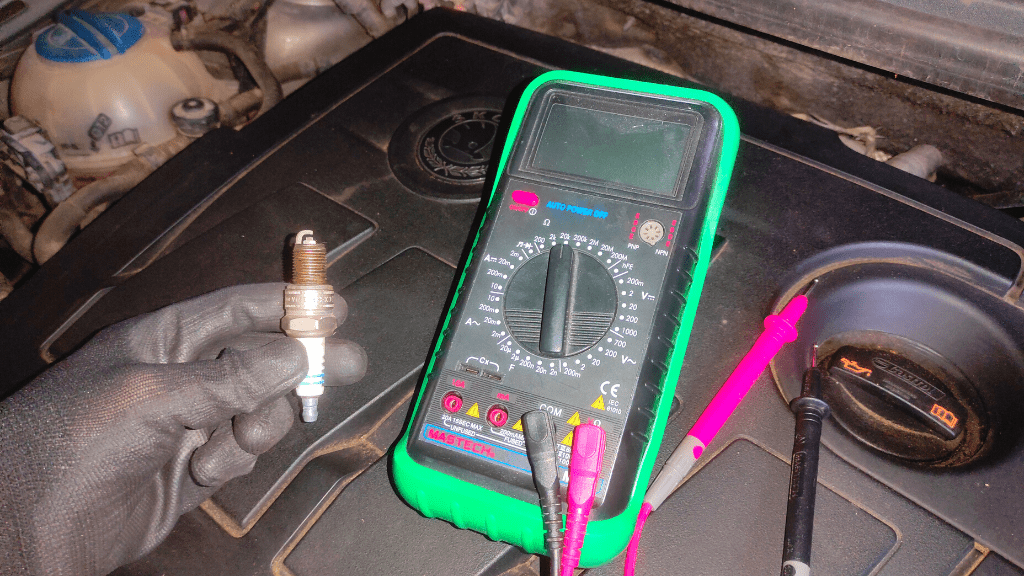
Tools Required To Test Spark Plug
To run a comprehensive diagnosis on a spark plug, you need
- Multimeter
- Spanner Set
- Insulated Gloves
- Protective goggles
Once your tools have been compiled, you move to the testing process.
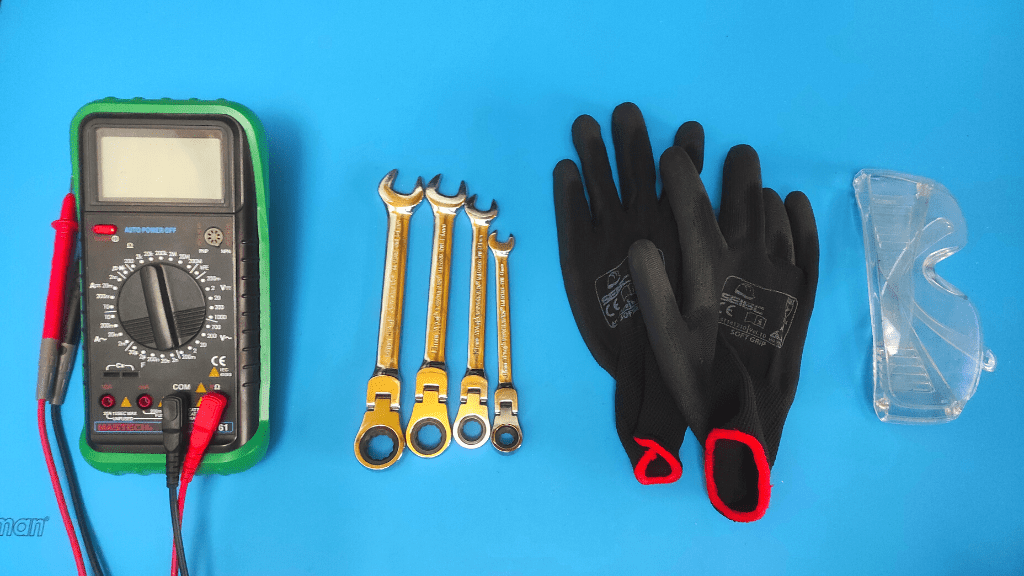
How to Test Spark Plug With Multimeter
With the spark plug taken out, set the multimeter to the 20k Ohm range, place a multimeter probe on the metal end that goes to the plug wire, and at the other end of the plug, place the other probe on the tiny rod coming from within it. A good plug has a resistance between 4,000 to 8,00 Ohms.
There is more to this testing process, as well as other ways to check if a spark plug is working properly or not and we will elaborate on these.
- Dry Out Fuel From Engine
The very first step you take is to dry out fuel within your engine to rid all its parts of inflammable liquids.
This is because one of our tests requires you to check for an electrical spark from the plug and you don’t want anything to catch up in flames.
Interrupt fuel supply to the engine by either taking out the fuse for the fuel pump (with fuel-injected systems) or disconnecting the tube linking the fuel tank to the fuel pump (as seen in carbureted engine systems).

Finally, you keep the engine running till the fuel burns out and, to prevent burns, wait for it to cool off before proceeding to the next step.
- Remove Spark Plug From Engine
The initial test we will explain requires you to completely detach the spark plug from your engine so you may have access to the parts to be tested.
Doing this usually needs you to unscrew the spark plug from the cylinder head and then disconnect the ignition coil from it.
How you disconnect the coil depends on the type of coil system you use. With Coil-on-Plug (COP) ignition systems, the coil is mounted directly on the spark plug, so you loosen the bolt holding the coil in place and remove it.
For coil pack systems, you simply pull out the wire that links the plug to the pack.
Once the coil has been detached, you then unscrew the spark plug from the cylinder head using a spanner that fits its measurement.

- Set Multimeter To 20k Ohms Range
For the initial resistance test, you turn the multimeter dial to the Ohms setting which is usually represented by the Omega symbol (Ω).
While doing this, you also make sure the dial is set to the 20k Ohms range. Given the expected resistance of a Spark plug, this is the most appropriate setting to get accurate results from the multimeter.
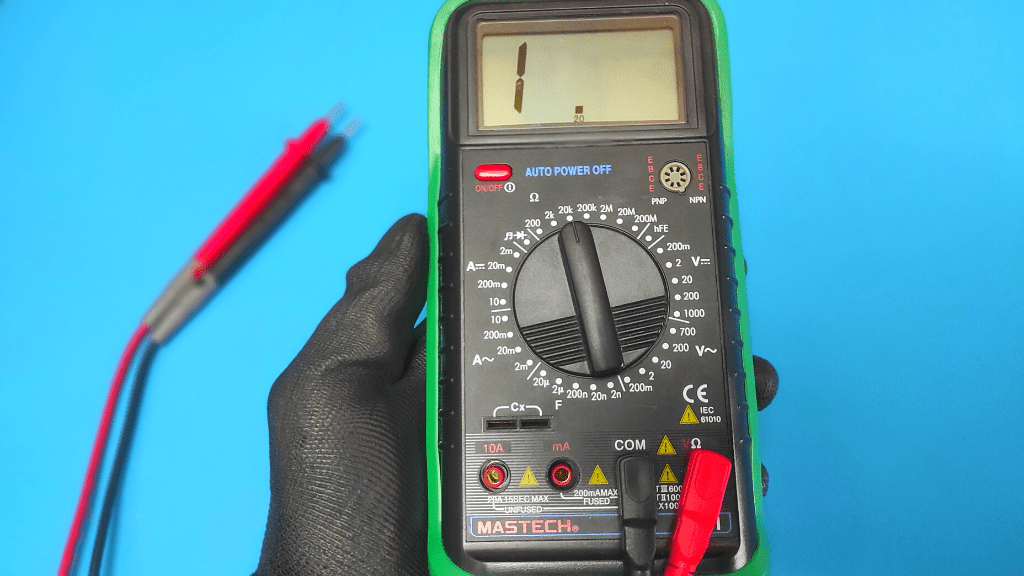
To test if the multimeter has been properly configured, place both leads on each other and see if you get zero (0) on the meter screen.
- Place Probes On Ends Of Spark Plug
Polarity does not matter in resistance tests.
Place one of the multimeter leads on the metal end from which you detached the coil, which is usually the thinner part of the spark plug. For the other probe, you want to place it on the copper-core center electrode, which is the thin rod coming from within the spark plug.
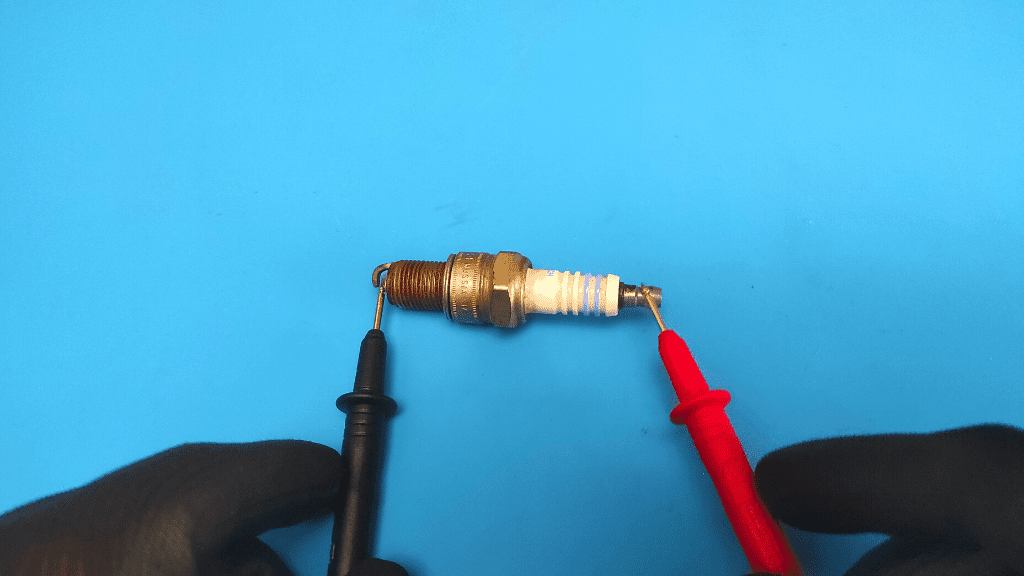
- Check Multimeter For A Reading
Now, it’s time to evaluate the results.
If the leads are making proper contact on the two parts of the spark plug and the spark plug is in good condition, the multimeter is expected to present you with a reading between 4 and 8 (4,000 Ohms and 8,000 Ohms).
There’s more to this, however.
The resistance range between 4,000 and 8,000 Ohms is for spark plugs with an “R” in their model number, which means they have an internal resistor. Spark plugs without a resistor are expected to present you with a value between 1 and 2 (1,000 Ohms and 2,000 Ohms). Check the manual of your spark plug for the right specifications.
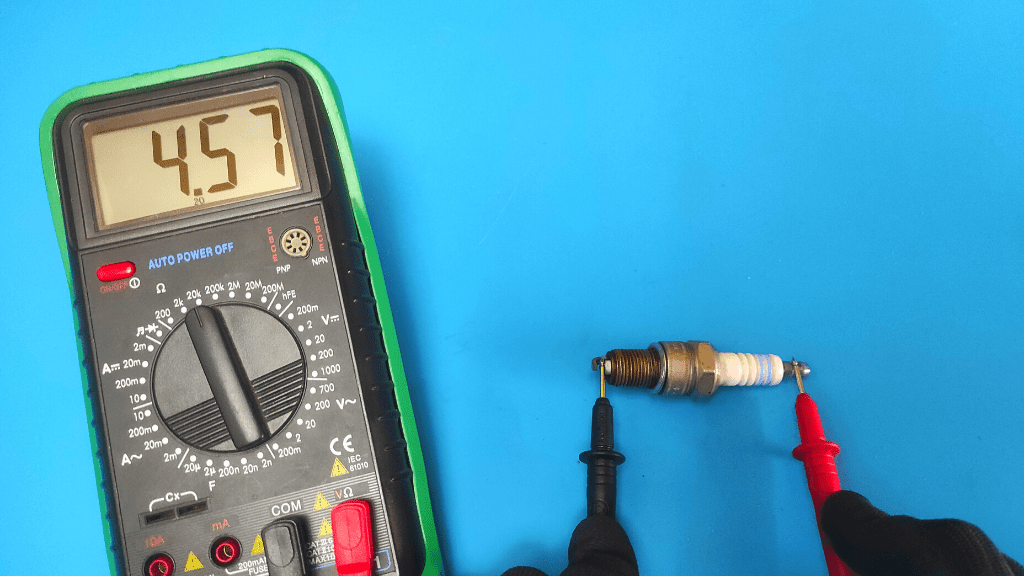
If you don’t get the right resistance reading, then your spark plug is faulty. The fault may be that the thin internal electrode has weakened, snapped completely, or there is a lot of dirt on the spark plug.
Clean the plug up with fuel and an iron brush, then test it again.
If the multimeter still doesn’t show an appropriate reading, then the spark plug has gone bad and you should replace it with a new one.
This is all about testing a spark plug using a multimeter.
You can also see this whole procedure in our video guide:
However, there is another way you may check if it is good or not, even though this test is not as specific as the multimeter test.
Testing Spark Plug Using Spark
You may know if the spark plug is good by simply checking if it produces a spark when engaged and also checking the color of the spark if it produces one.
The spark test helps you to easily find out if the problem is with the plug or other parts of the ignition system.
After drying out your engine, proceed to the following steps.
- Put On Safety Gear
The spark test involves you dealing with a voltage pulse of up to 45,000 volts.
This is very harmful to you, so you want to wear rubber insulated gloves and safety goggles to prevent shock hazards.

- Unscrew Spark Plug From Cylinder Head
Now, you don’t totally remove the spark plug from the engine. You only unscrew it from the cylinder head and leave it connected to the coil.
This is because you need it to receive a pulse of voltage from the coil to produce a spark and you also need it outside the cylinder head to see the spark.
- Ground The Spark Plug
Ordinarily, while the spark plug is screwed into the cylinder head, it is usually grounded through its metal screw threads.
Now that you have removed it from its grounded slot, you have to provide it with another form of grounding to complete the circuit.
Here, you simply find a metal surface close to the spark plug connection. Don’t worry, there are a lot of metal surfaces close by.
You should additionally keep the connection away from any fuel source to avoid inflammations.
- Ignite Engine And Evaluate Results
Turn your ignition key to the start position like you want to start the car and see if the plug produces any spark. If you see a spark, you check if it is blue, orange, or green.
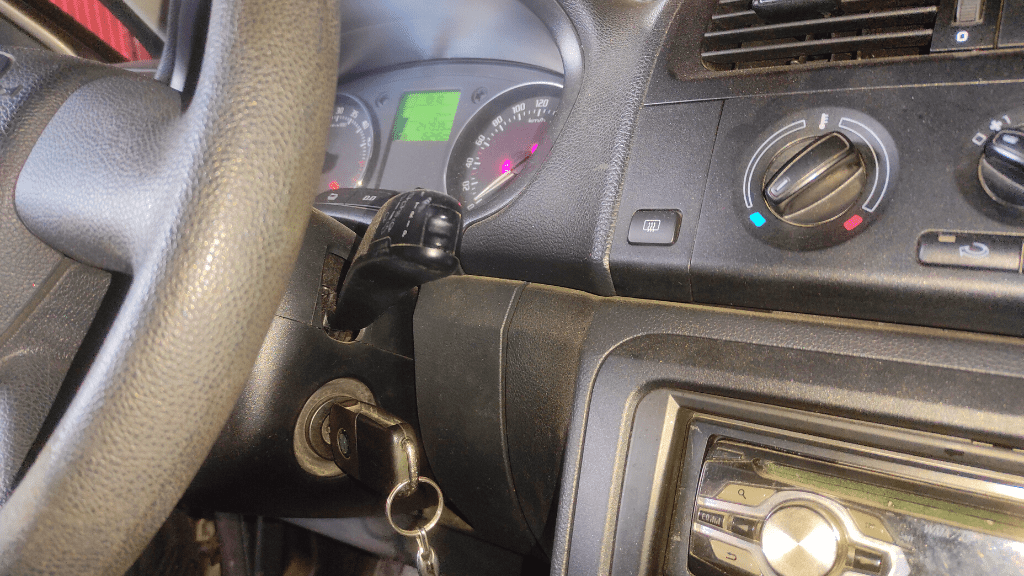
Blue sparks mean the spark plug is good and your problem could be with the cylinder head or other parts of the ignition system after the spark plug.
Orange or green sparks, on the other hand, mean it is too weak to function within the ignition system and should be replaced. However, you can’t write it off yet.
You want to run the test with one you know is working to identify the exact problem.
You remove the installed plug from the coil, replace it with a preferably new spark plug with the same ratings, try to start the engine, and see if you get any spark.
If you get a spark from the new plug, you know that the former spark plug is bad and should be replaced. If you don’t get a spark, however, you understand the problem may not be with the spark plug but with other parts of the system.
You then test the coil pack, look at the plug wire, test the starter, and run diagnostics on other parts of the ignition system leading to the spark plug.
Conclusion
Diagnosing a spark plug is a fairly easy task you may run within your home without having to call an auto-mechanic.
If the spark plug seems to be working well, you proceed to sequentially check out other parts of the ignition system to find the exact problem with your vehicle.
Frequently Asked Questions
How Can You Tell If A Spark Plug Is Bad?
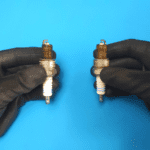
If your car spark plug is bad, you experience symptoms like unusual knocking sounds from the engine, difficulty starting the vehicle, increased fuel consumption, sudden loss of power, and misfiring.
How Many Ohms Should A Spark Plug Read?
A good spark plug has a resistance between 4,000 Ohms and 8,000 Ohms if it has an internal resistor, or between 1,000 Ohms and 2,000 Ohms if it doesn’t. A value outside this means it has gone bad.

Author
Alex Klein is an electrical engineer with more than 15 years of expertise. He is the host of the Electro University YouTube channel, which has thousands of subscribers.
